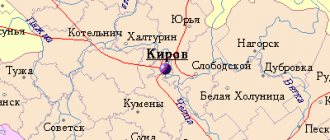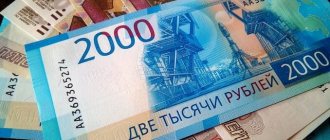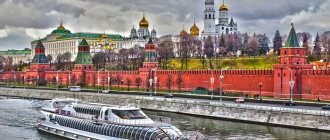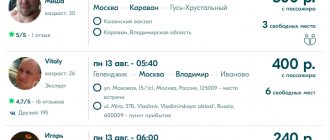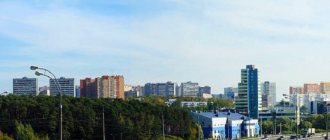In a very popular song in the USSR, Moscow was called “the best city on Earth,” and all Soviet citizens, who then did not have the opportunity to freely move around the world, joyfully agreed with this. But recently, objective reasons for such an assessment have emerged - the Russian capital has begun to occupy the highest positions in various international rankings and has entered the elite of the world's megacities. Read about the indicators by which Moscow is ahead of many cities on the planet today in the Lenta.ru article.
Criteria for evaluation
Modern international ratings assess the attractiveness of megacities for living and doing business, based on such characteristics as quality of life, accessibility of medicine and education, development of electronic services, transport situation, comfortable environment for entrepreneurs, rate of increase in prices for consumer goods and travel. They are formed both by world-famous media and popular Internet portals, and by specialized international experts from various authoritative organizations, therefore they differ from each other in target audience, and in data sources, and in analyzed parameters, and in other evaluative characteristics.
International ratings and approaches differ. For example, large companies specializing in the real estate market maintain their own database, monitor online advertisements, and the like. At the same time, global rating agencies often not only monitor business transactions and reporting, but also rely on their own sources of information and order expensive research. In addition, ratings can also be formed from purely subjective assessments based on the personal preferences of the respondents. So, for example, when determining on a travel website the best city for a winter holiday, some will choose Vienna, some will choose Bucharest, and there are others who will prefer Prague.
Muddy river or meandering river?
If the name Moscow comes from the Baltic languages, then its source could be the Baltic forms *Mask-(u)va, *Mask-ava or *Mazg-(u)va, *Mazg-ava (Latvian Maskava). The root *mask-/*mazg- could be associated both with swamp, mud, and with the “knot” (mazgas in Lithuanian), washing by the river from the verbs “to wash, rinse” (Lithuanian mazgoti, Latvian moskat).
Accordingly, the origin of the name can be traced back to both the marshy, dirty terrain - which is consistent with the Slavic hypothesis - and to the tortuosity of the Moscow River - only within the city it makes 11 large loops.
Moscow River. Photo: www.globallookpress.com
Comfort comes first
According to the results of the ranking of the 100 best cities in the world, prepared this year by the consulting company Resonance Consultancy, the Russian capital entered the top 5. According to authoritative international experts, in Moscow you can get to the airport faster than in a hundred other world capitals. In addition, according to their estimates, a large number of well-maintained parks, excellent restaurants, modern concert venues and excellent museums allow citizens to not even leave the city during their vacation.
In terms of recreational infrastructure and the route network of airports, Moscow is ahead of Chicago, Dubai, Singapore and San Francisco, second only to London and Paris, which have long been established as transport hubs and world cultural centers.
Photo: Alexander Avilov / AGN “Moscow”
And according to the results of the Cities in Motion ranking of the University of Navarra Business School (IESE), in which the quality of life in 174 cities around the world is assessed comprehensively, the Russian capital is among the top ten leaders in the categories of “human capital” and “urban planning.” In this ranking, Moscow rose from twenty-second place to sixth in one year.
If we talk about the relatively recent past, then a lot of complaints from citizens were caused by the poor accessibility of government services; just remember the eternal queues for any, even the most trivial certificate. In recent years, queues at government offices have practically disappeared in our capital; the average waiting time at the MFC has actually decreased to five minutes. Today you can pay utilities without leaving your home, submit an application to the registry office or, for example, complain about the work of a janitor. Thanks to this, Moscow entered the top ten most developed cities in the UN ranking for the provision of electronic services, ahead of Seoul, Berlin and London. After all, the availability of government services is an important indicator of the quality of city life.
It is curious that the Russian capital is now considered a city that is attractive to wealthy people, and in the Forbes ranking this year Moscow ranked third in the number of billionaires living there, behind only Hong Kong and New York. Today it is home to 70 billionaires, whose total capital is estimated at $301.7 billion. The financial condition of these people allows them to live in any of the most luxurious places in the world, but they chose Moscow, thereby demonstrating that the Russian capital is not inferior to leading metropolises in terms of quality of life.
Moscow is also perceived as a brand; it is not for nothing that the international consulting company Global City Lab, based on a study of the value and influence of city brands, placed the capital in 21st place out of 500.
Photo: Alexander Miridonov / Kommersant
St. Petersburg metro
Opened on November 15, 1955. Unlike Moscow, it does not have ring stations. Consists of 5 branches and 72 stations. The St. Petersburg metro is the deepest in the world, if measured by the average depth of stations. The Admiralteyskaya station is located at a level of 86 meters underground and is closest to Palace Square, the Admiralty and St. Isaac's Cathedral.
The St. Petersburg metro opens at 5:38 and closes at 0:28 (the schedule is relevant for most stations, but not for all). On holidays and major sporting events, opening hours are sometimes extended. Payment is made using metal tokens, travel cards or bank cards. The cost of one journey is 55 rubles. When going up or down an escalator, it is customary to take the right side so that those in a hurry can run up on the left.
St. Petersburg metro map
Transport accessibility
It has long been no secret that the Russian capital is a complex and problematic city for organizing transport traffic. Therefore, it is especially pleasant that the international marketing research agency Kantar, in its ranking of transport systems, highly appreciated the work of the Moscow authorities in developing urban transport infrastructure, awarding Moscow third place among 31 global metropolises. Everything that expands the opportunities for Muscovites in terms of transport accessibility was taken into account: the development of car sharing and bicycle rental, and the modernization of the ground public transport system. In addition, this year the Moscow Transport ticket system won the “Best Smart Ticketing System” category at the Transport Ticketing Global Awards.
But we must honestly admit that, despite such serious achievements in the development of the capital’s transport infrastructure, complete victory is still far away - the capital is still among the cities with the largest traffic jams. Although it managed to leave the top 5 busiest cities in the world in the TomTom ranking this year, much more needs to be done to completely solve the problem.
swampy river
The most patriotic Slavic hypothesis of the origin of the name Moscow suggests that its basis is “mosk”. This word in the ancient Slavic language meant “viscous, wet” or “swamp, dampness, moisture.” This hypothesis is supported by other similar names of rivers in Slavic languages: Mozgava or Moskava in Poland and Germany, the Moskovets River and the village of the same name in Bulgaria, the Maska River in Belarus, numerous Moskovki in Ukraine. It was mentioned that around Borovitsky Hill there was not only a forest (which gave the name to the area), but also swampy terrain, lowlands that were filled with water in the spring, which did not dry out until the end of summer.
Article on the topic
Two Moscows. Past and present of the capital
Critics of this hypothesis are based on the fact that the Slavic tribes were not the original inhabitants of this area. Previously, tribes lived here who spoke Finno-Ugric and Baltic languages, which was reflected in the names of many neighboring rivers: Ruza, Istra, Nara, Yauza, Iksha, Vondyuga, Kuyma, Kurga and so on.
City for business
The positions of the Russian capital in ratings assessing the city’s economic potential, its infrastructure, business climate, and workforce qualifications are also impressive.
“According to one of the key economic indicators—the volume of investment in fixed capital—Moscow has been growing steadily over the past decade. Even despite all the restrictions associated with the pandemic, in the first half of 2022 this figure increased by 8.2 percent, and taking into account inflation it is 2.3 times higher than the volume of investments in fixed assets in 2010,” Lente reported. ru" Vice-Mayor for Economic Policy and Property and Land Relations Vladimir Efimov. It.
According to Vladimir Efimov, “today Moscow business continues to implement long-term projects and is ready to adapt its plans to new realities. Such business optimism from investors is an important indicator of business confidence, which we will always support by building a constructive dialogue with the business community and promptly responding to its requests.”
Therefore, it is not surprising that in the ranking of the most attractive cities for investors by fDi Intelligence (a division of The Financial Times), Moscow entered the top five in both the categories “Human Capital” and “Conditions for Doing Business”, and in the top 10 in terms of “ Economic Potential" and "Cost Efficiency" among the largest European cities.
Photo: Sergey Vedyashkin / AGN “Moscow”
Since 2008, in the GaWC ranking of global cities at Loughborough University (UK), Moscow has maintained its position in the top-level Alpha group along with Toronto, Sydney, Madrid, Zurich, and Seoul. The GaWC ranking measures the level of corporate globalization among companies operating in the accounting and auditing, advertising, banking and management consulting sectors, that is, in the areas that have the greatest impact on the economic relationships between countries, cities and businesses.
The Russian capital also feels confident among cities with the best prospects for economic development. Thus, in the LaSalle ranking of European centers of economic growth for 2022, it rose by 48 positions and entered the top 50. The Analytical Center of the City of Moscow believes that this happened due to the expansion of the labor market and the improvement of the economic well-being of the city.
In the Mori Global Power City Index (GPCI) ranking for 2022, Moscow ranked third out of 48 in terms of unemployment rate, and first in terms of work schedule flexibility (early leaving work and remote work). By providing city residents with good opportunities for professional development and comfortable living conditions, the capital successfully competes with the world's largest megacities.
At the beginning of 2022, the compilers of the Z/Yen rating of global financial centers especially noted the development of the business environment and the diversity of the financial industries of the capital and included Moscow in the category of “Global Diversified Financial Centers”, putting it on a par with Paris and Seoul. Despite the global crisis, judging by the autumn report, Moscow immediately rose nine places in the ranking and took 62nd place out of 111 among the world's largest financial centers. This is the best result since 2011.
The success of the Russian capital is reflected in its ranking in the Eastern Europe and Central Asia regions, where Moscow ranks second and is one of three cities, along with Istanbul and Athens, that managed to not only maintain, but also improve their positions. Cities here are assessed according to five criteria: business climate, financial sector development, human capital, infrastructure and reputation, and about three thousand financial experts from around the world also participate in the formation of this rating.
Photo: Alexander Kazakov / Kommersant
According to the American business magazine Fortune, four Russian companies with headquarters in Moscow are in the ranking of the largest Global 500 companies for 2022, and the global top 100 companies by income include Gazprom, Lukoil and Rosneft.
Since the COVID-19 pandemic has become a serious test of strength for all of the world's largest metropolises, without exception, this has required their authorities to make calibrated and prompt decisions to protect not only residents, but also the economy. The anti-crisis program of the Moscow government to support the capital's business was noted in a study by the international consulting company EY. According to the authors of the study, the set of emergency measures proposed by the Moscow authorities to business during the pandemic positively distinguishes the capital not only among Russian regions, but also among the world's largest metropolises.
Kazan metro
This metro is the youngest - in 2022 it will be only 15 years old. The Kazan metro was opened in 2005, timed to coincide with the 1000th anniversary of the city. Interestingly, this is the first metro built on the territory of the former USSR. So far, the Kazan metro is the only line with 11 stations, 17 km long. But in the spring of this year they have already taken up the construction of line 2.
The fare in the capital of Tatarstan is 30 rubles (27 on the Unified Transport Card). Standard operating hours: from 6:00 to 24:00.
Kazan metro map
City of Startups and Innovations
Moscow is becoming more and more attractive in terms of the conditions created here for startups. Thus, according to the StartupBlink research center, in 2022 the Russian capital ranked ninth among cities in the world in developing ecosystems for startups, and in the new Findexable ranking it was ranked seventh in Europe in developing the financial technology ecosystem.
President of the Institute of Urban Economics Foundation Nadezhda Kosareva believes that creating conditions for innovation is one of the most difficult management issues, which all the largest cities in the world are struggling to solve when competing for human capital. According to her, “Moscow is creating such conditions in several directions at once. This includes financial support for start-ups and innovations, organizational support, creation of innovation clusters, technopolises, assistance in testing projects and much more. The Russian capital uses many traditional, proven methods of supporting innovative development, which produce positive results.”
The expert claims that “in the future, ultra-modern approaches will appear, the so-called “innovations of innovation process management,” which will provide a new format for the development of this direction, which is strategically important for every metropolis.”
StartupBlink also prepared a ranking of cities based on the number of innovative solutions to combat the coronavirus pandemic, in which Moscow is ranked seventeenth. Capital companies offered 51 solutions to combat the pandemic, including a platform for analyzing and processing medical images using artificial intelligence technologies Botkin.AI and a self-isolation index from.
The attractiveness of the city for the development of startups was also noted by fDi Intelligence; according to their version, Moscow entered the top twenty ranking of the most promising cities in Europe for investment in technology, innovation and startups. The ranking analyzed 76 European cities, which were assessed in terms of attracting capital, availability of qualified employees and infrastructure development. This year, the Russian capital took eighteenth place, and in one of the five rating categories, “Startup Ecosystem,” it immediately rose to tenth place.
Photo: Sergey Vedyashkin / AGN “Moscow”
And in the global index of innovative cities of the world by the 2thinknow agency, published in November 2022, over the year Moscow rose immediately by ten points and took 38th place out of 500. The leaders were New York, Tokyo, London, Los Angeles and Singapore, and the capital of Russia scored the same number of points as Osaka, Vancouver, Portland and Las Vegas.
But 2thinknow is far from the only international company that celebrates the achievements of the main metropolis of Russia in the development of innovation. For example, the consulting company Tholons, in its Services Globalization Index report, included the Russian capital among the twenty world leaders in digital transformation. This rating evaluates cities not only according to such traditional criteria as the development of the business environment and safety, but also by the introduction of innovation and digitalization. According to the Analytical Center of the City of Moscow, the “Digitalization and Innovation” group received the greatest weight in calculating the final rating - 40 percent of the total rating, whereas previously it was 25 percent. It was there that the capital’s indicators increased 1.5 times. In addition, Moscow’s indicators in the “Safety and Quality of Life” group have also significantly improved.
The achievements of the main city of Russia as an innovation cluster are confirmed by the World Intellectual Property Organization of the UN. In the Global Innovation Index 2020, Moscow took 32nd place, having risen by 25 points in three years.
Novosibirsk metro
The Novosibirsk metro was launched immediately after the Nizhny Novgorod metro - on January 7, 1986. Currently it has 2 lines and 13 stations. The travel time from the first to the last station of the line is 10-15 minutes. The token costs 25 rubles. But if you buy a single transport card, it will be cheaper. Opening hours: from 6:00 to 23:00.
The main attraction of the Novosibirsk metro is the longest metro bridge in the world. It is thrown across the Ob River and its length is 2145 meters. Connects the stations "Studencheskaya" and "Rechnoy Vokzal".
Scheme of the Novosibirsk metro
Sustainable development
Moscow’s strategic documents include tasks for implementing the sustainable development goals (SDGs) adopted by the UN. Since 2022, the capital has been participating in the pilot project of the Organization for Economic Cooperation and Development (OECD) “Territorial approach to achieving the SDGs.” Based on preliminary analysis published in February this year, Moscow outperformed the OECD average in four of the eight SDGs assessed. In addition, for a number of indicators, for example, the number of doctors per thousand people, the capital has reached the final value.
According to Svetlana Gerasimova, head of the MIRBIS School of CSR and Sustainable Development, senior lecturer at the Basic Department of FAS of Russia, Plekhanov Russian University of Economics, “the sustainable development approach provides a comprehensive consideration of the economic, environmental, and social aspects of city development. Issues of convenience of urban spaces, development of social and urban infrastructure, alternative energy, digital solutions, and the use of recycling technologies are not only important for various groups of residents, but also become assessment scales in ratings of sustainable development of territories.” She believes that “international ratings stimulate megacities to grow and allow them to focus on improving certain indicators and implementing specific projects.”
According to Svetlana Gerasimova, “the period from 2022 to 2030 is called the Decade of Action to Achieve the UN SDGs, and Moscow is confidently developing best practices in the most significant and significant areas of development. It is important that the international expert community, based on various assessment methods, gives such work high marks.”
The first Voluntary National Review of Russia, which was presented at the UN, spoke about Moscow’s contribution to achieving sustainable development goals and especially noted the specialized employment center “My Career”, the “Moscow Longevity” project for older Muscovites and the “Active Citizen” portal.
An eco-friendly environment is one of the indicators of sustainable development. In the 2022 IQAir World Regional Capital City Ranking, which compares the level of exhaust gas concentrations in world capitals, Moscow improved its position by 17 points and is now, together with Berlin, Stockholm and Helsinki, in the group of capital cities with the best air quality according to WHO requirements for the concentration of suspended particles PM2.5.
Samara metro
The Samara metro is one line 12.6 km long. It consists of 10 stations and bears the name of the Soviet statesman Alexei Andreevich Rosovsky, who actively built Samara in the 60-80s. Moreover, the metro was opened in 1987, and the name was given in 2013.
A token costs 32 rubles, but a trip using the Unified Transport Card will cost 29 rubles. The metro starts operating at 6:00 and ends at 24:00. The interval between trains is 10-12 minutes. Passenger traffic is low, which you would probably consider a good thing if you were on the Moscow metro during rush hour.
Samara metro map
List of largest agglomerations in the world
As I already wrote above, an agglomeration is a large number of cities and other settlements fused together, without clear boundaries, smoothly flowing with each other. The largest agglomerations in the world are located in the Asian region. The leaders among agglomerations are Tokyo-Yokohama; the population of this agglomeration is (just think about it) more than 38 million people . The largest agglomeration in Europe is Moscow, with a population of about 16.8 million people. Below is a list of the top 50 largest agglomerations in the world for 2022 :
| № | Agglomeration | A country | Region | Population |
| 1 | Tokyo - Yokohama | Japan | Asia | 38505229 |
| 2 | Shanghai | China | Asia | 34000000 |
| 3 | Jakarta | Indonesia | Asia | 31689592 |
| 4 | Manila | Philippines | Asia | 25514000 |
| 5 | Seoul | South Korea | Asia | 25000000 |
| 6 | Guangzhou | China | Asia | 24900000 |
| 7 | Beijing | China | Asia | 29300000 |
| 8 | NY | USA | North America | 23522861 |
| 9 | Shenzhen | China | Asia | 23300000 |
| 10 | Delhi | India | Asia | 21753486 |
| 11 | Mexico City | Mexico | North America | 21650668 |
| 12 | Sao Paulo | Brazil | South America | 21242939 |
| 13 | Lagos | Nigeria | Africa | 21000000 |
| 14 | Mumbai | India | Asia | 20748395 |
| 15 | Cairo | Egypt | Africa | 20500000 |
| 16 | Kyoto-Osaka-Kobe | Japan | Asia | 19342000 |
| 17 | Wuhan | China | Asia | 19000000 |
| 18 | Los Angeles | USA | North America | 18764814 |
| 19 | Chengdu | China | Asia | 18100000 |
| 20 | Dhaka | Bangladesh | Asia | 17151925 |
| 21 | Chongqing | China | Asia | 17000000 |
| 22 | Karachi | Pakistan | Asia | 16900000 |
| 23 | Moscow | Russia | Europe | 16855000 |
| 24 | Tianjin | China | Asia | 15400000 |
| 25 | Istanbul | Türkiye | Europe Asia | 15067724 |
| 26 | Bangkok | Thailand | Asia | 14626225 |
| 27 | Calcutta | India | Asia | 14617882 |
| 28 | Tehran | Iran | Asia | 14595904 |
| 29 | London | United Kingdom | Europe | 14187146 |
| 30 | Hangzhou | China | Asia | 13400000 |
| 31 | Chennai | India | Asia | 13300253 |
| 32 | Surabaya | Indonesia | Asia | 13123948 |
| 33 | Buenos Aires | Argentina | South America | 13074000 |
| 34 | Xi'an | China | Asia | 12900000 |
| 35 | Paris | France | Europe | 12568755 |
| 36 | Changzhou | China | Asia | 12400000 |
| 37 | Kinshasa | DR Congo | Africa | 12350000 |
| 38 | Rio de Janeiro | Brazil | South America | 12330186 |
| 39 | Hyderabad | India | Asia | 12252068 |
| 40 | Shantou | China | Asia | 12000000 |
| 41 | Nanking | China | Asia | 11700000 |
| 42 | Bangalore | India | Asia | 11695110 |
| 43 | Rhine-Ruhr | Germany | Europe | 11471732 |
| 44 | Lahore | Pakistan | Asia | 11070000 |
| 45 | Jinan | China | Asia | 11000000 |
| 46 | Harbin | China | Asia | 10500000 |
| 47 | Lima | Peru | South America | 9886647 |
| 48 | Chicago | USA | North America | 9866910 |
| 49 | Washington-Baltimore | USA | North America | 9797063 |
| 50 | Zhengzhou | China | Asia | 9700000 |
